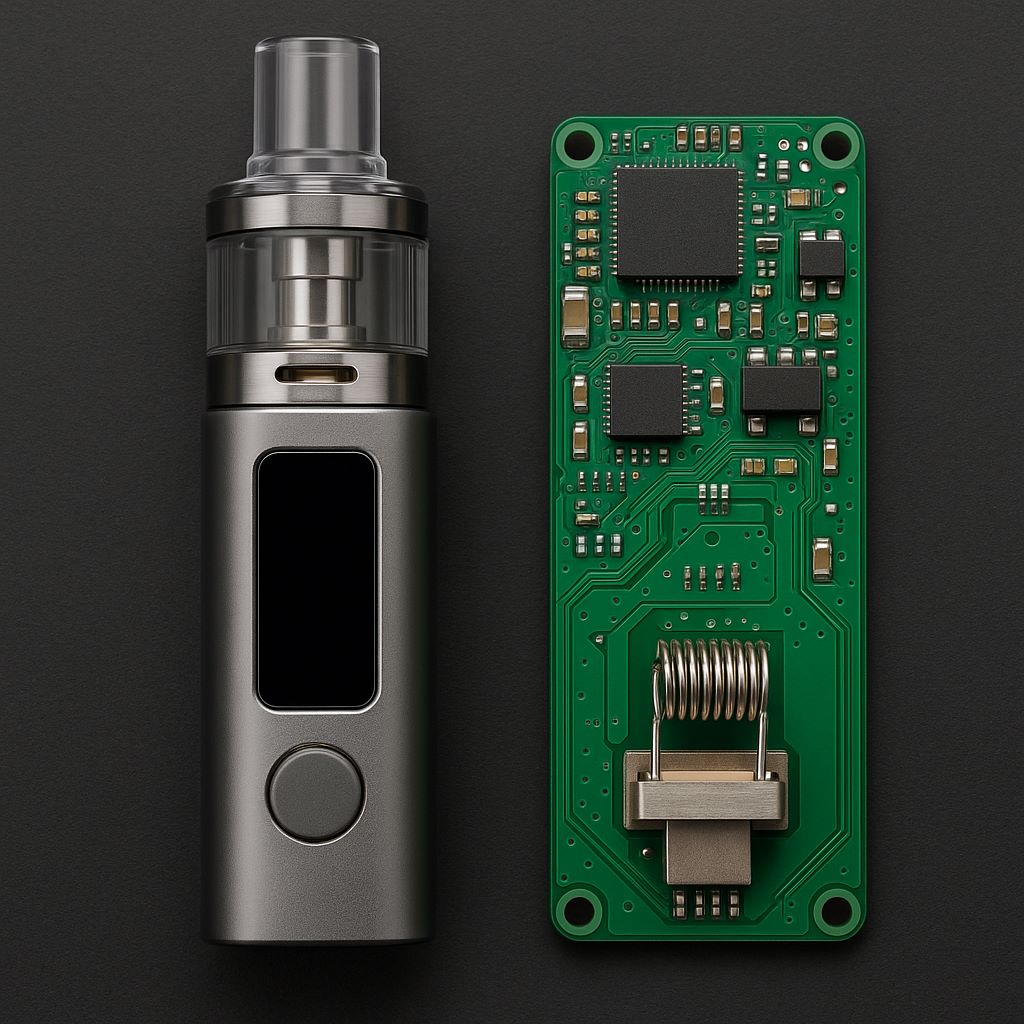The Evolving Demands of Vape Core Design
The global vape industry has grown dramatically. Customization, intelligence, and performance have become key differentiators in product competitiveness. At the heart of every premium e-cigarette lies a high-performance PCB module. This module controls not only power delivery, but also heating behavior, user feedback, safety protocols, and—most crucially—temperature regulation and activation speed.
Custom e-cigarette core components today must offer more than simple power management. They must integrate advanced control algorithms, ultra-fast response time, and adaptable form factors that suit various product tiers. In particular, temperature control and quick activation are now essential features for delivering a superior vaping experience while staying compliant with regional regulations.
In this guide, we’ll explore how to strategically upgrade your PCB designs to support these two functionalities while maintaining stability, manufacturing scalability, and long-term user satisfaction.
The Strategic Importance of Temperature Control in Vape PCBs
Temperature control in modern e-cigarette systems is not merely a technical upgrade; it defines how brands position themselves in premium or regulatory markets.
By dynamically adjusting power output based on real-time resistance feedback from the coil, temperature control prevents dry hits, protects wicks, enhances flavor delivery, and ensures consistent vapor quality.
From a hardware perspective, this requires:
-
A temperature-sensing mechanism (via coil resistance)
-
A responsive microcontroller unit (MCU)
-
A closed-loop algorithm to regulate output in real time
When executed properly, temperature-controlled vaping helps:
-
Extend coil and battery life
-
Create smoother throat hits
-
Reduce harmful byproducts from overheating
For brands entering health-conscious or medically regulated markets, temperature control can serve as a compliance enabler and a critical selling point.
Quick Activation: Redefining User Experience Standards
In the realm of competitive e-cigarette design, activation lag is unacceptable. Gen Z and millennial consumers demand instant-on vapor production that mimics traditional smoking without delay.
Quick activation functions by:
-
Reducing delay between trigger input and power output
-
Leveraging pre-heating algorithms to anticipate firing
-
Utilizing low-impedance MOSFETs and optimized traces to reduce signal latency
However, achieving fast response time involves more than just shortening the signal path. The entire PCB layout—from battery trace width to firmware timing—must be optimized to support near-instant firing.
Consumer feedback consistently supports the notion that “responsiveness” is directly correlated to perceived quality. Therefore, quick start-up capability becomes a direct contributor to brand loyalty.
Essential Components of an Upgraded Core Module
When designing or upgrading a vape PCB for these functions, the following elements are foundational:
1. Microcontroller Unit (MCU)
-
Should support ADCs for temperature estimation
-
Must run closed-loop PID control logic
-
Should enable ultra-fast boot routines
2. Power Management ICs
-
Buck/Boost converters ensure voltage stability under varying battery conditions
-
Integrated protections: overcurrent, overvoltage, reverse polarity
3. MOSFET Switching System
-
Supports pulse-width modulation (PWM)
-
Provides fast, efficient, low-resistance switching
-
Key to reducing delay in quick-start response
4. Temperature Feedback Loop
-
Real-time resistance readings from coil allow for thermal estimation
-
Requires a low-noise analog front end
5. Firmware Layer
-
Contains timing logic, temperature limits, and user presets
-
Offers upgradeability via USB or wireless interfaces
6. Safety Protocols
-
Thermal shutdown at unsafe levels
-
Battery protection in under-voltage scenarios
-
Short-circuit and open-load detection
Design Methodology: PCB Layout for High-Performance Vaping
PCB design directly influences temperature stability and power responsiveness. Therefore, layout strategy must address:
-
Trace Optimization: Wider power paths, minimized ground loops, and centralized return paths
-
Thermal Dissipation: Copper pours and thermal vias beneath MOSFETs and coils
-
Component Placement: Short distances between MCU, FETs, and sensing elements
-
Layer Stack: 4-layer boards with dedicated power and ground planes reduce noise
As quick activation requires efficient signal delivery and current management, the PCB layout must act as a thermal and electrical highway rather than a simple connection medium.
Manufacturing Challenges & Solutions
As functionality increases, so do production demands. Tight component tolerances and small board sizes can introduce risks such as:
-
Solder bridging on fine-pitch MCUs
-
Inconsistent sensor placement impacting temperature readings
-
RF interference in wireless-enabled boards
To mitigate these:
-
Use high-TG (glass transition temperature) FR-4 substrates or ceramic composites
-
Deploy automated optical inspection (AOI) at multiple stages
-
Co-design firmware and hardware to allow calibration tolerances
Custom e-cigarette core components must be as manufacturable as they are functional. The cost-performance balance must be carefully maintained.
Future Trends in E-Cigarette Core Board Development
Looking ahead, the next generation of custom PCB designs will likely integrate:
-
Based user preference detection
-
Haptic feedback for enhanced tactile feel
-
Energy harvesting or wireless charging
-
Cloud-synced usage tracking for health management
Temperature control and activation time will continue to be refined, and more real-time sensors (humidity, airflow) will shape the vaping ecosystem. Thus, future-proofing PCB design today means embedding modularity and software flexibility from the outset.
บทสรุป: Core Functionality Defines Core Value
Upgrading the design of your custom e-cigarette core components is not just a technical exercise—it is a strategic investment. Temperature control ensures user safety, satisfaction, and regulatory compliance. Quick activation improves first impressions and builds brand loyalty. Together, these features elevate your vape product from a commodity to a premium experience.
For OEMs, ODMs, and vape brands seeking to differentiate in crowded markets, an optimized PCB is the engine that powers distinction.
At รินยา, we specialize in full-stack PCB customization, from schematic design to firmware integration. Whether you are building an entry-level disposable or a high-end smart vape, our solutions support precise control, high performance, and scalable production.
Now is the time to invest in smarter PCB design—because your product is only as strong as its core.

